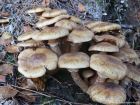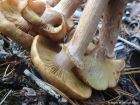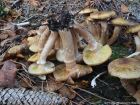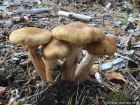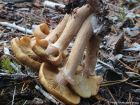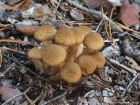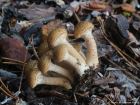Cap hemispherical, eventually flattening, honey-yellow, darker in the centre with a dense covering of brown scales, translucent-striate when moist and especially as it ages along the edges. The flesh is white, thin and firm. Gills adnate or weakly decurrent, white, later becoming yellowish with brown spots. In young mushrooms, the gills are covered by a white veil. Once the veil detaches from the cap's edge, it remains hanging as a ring around the stem. Stem more and less equal but it can also be club-shaped and quite thick at the base. It is palest at the apex, yellowish-brown at the base, and the surface has persistent yellowish woolly scales. The upper part of the stem features a strong, cottony ring, which is speckled brown on the underside. Spore print very pale cream.
Microscopic Features: The spores are ellipsoidal, smooth, typically contain guttules, measure 7.5-10 x 5-7 µm, and are amyloid in reaction.
Armillaria borealis on the First Nature Web site.
Many mushrooms are poisonous, and some can be lethally toxic. Distinguishing between edible and poisonous mushrooms can be very challenging. Therefore, we strongly advise against consuming wild mushrooms. This website does not contain any information about the edibility or toxicity of mushrooms.
Although efforts have been made to ensure accuracy on this website, the information may contain errors and omissions. Therefore, all content provided is for educational and informational purposes only and should not be relied upon or used as a basis for consuming any plants or mushrooms.
External links are provided for reference only. We do not endorse or take responsibility for the content, advice, or products found on these sites or in any advertisements shown on this website.
